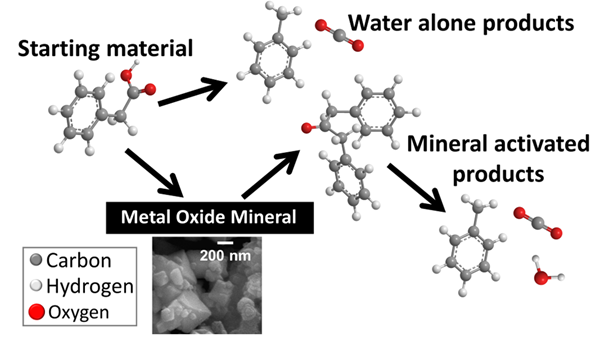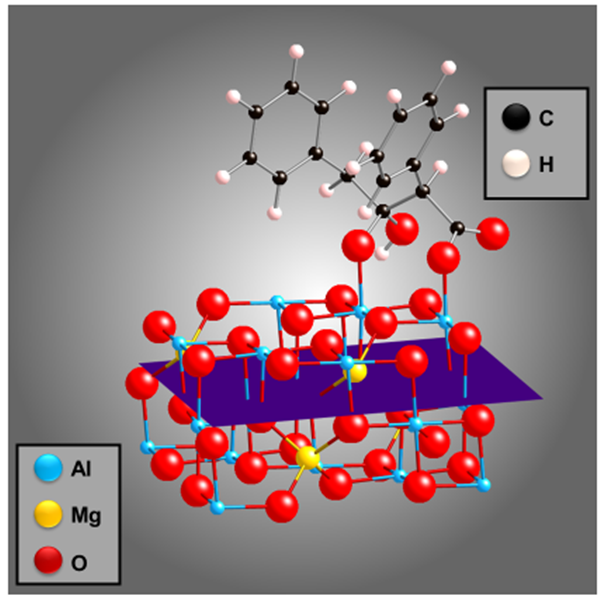Through a combination of careful hydrothermal experiments and thermodynamic calculation, the activation of a ketone forming pathway was observed from carboxylic acids in the presence of different metal oxide minerals. This reaction pathway was not previously considered in the interpretations of aqueous organic geochemistry, even though the formation of ketones is a well-known industrial process that occurs on mineral surfaces. The presence of metal oxide minerals increased the number and variety of reaction paths available to phenylacetic acid (an aromatic carboxylic acid), compared to reactions without minerals. However, yields were not the same in all cases.
Carboxylic acids are an abundant organic compound found in an array of different environments ranging from carbonaceous chondrite meteorites that form without life, to the biological metabolic pathways that fuel life. Understanding the fundamental organic chemistry that can exist in a geologic setting provides with snapshots of the chemistry that could have existed on the early Earth before the formation of life itself. This study demonstrates a new reaction pathway for reactions of carboxylic acids (organic compounds containing the carboxyl functional group -COOH) in the presence of minerals (solid, naturally occurring inorganic substances) at hydrothermal conditions [Figure 1].

Hydrothermal conditions can create a favorable environment for organic chemical reactions that water at room temperature is otherwise unable to provide. The combination of both hydrothermal conditions (for this study 300°C and 1000 bar [100MPa]), with mineral surfaces causes the formation of reaction pathways that form carbon-carbon bonds. Through thermodynamic calculations it is predicted that favorability of the reaction at different temperatures [Figure 2]. Initially, it was believed that hydrothermal chemistry would only result in the breakdown and destruction of organic compounds, but study has demonstrated that this is not the case. The reaction explored in this study is the formation of ketones (organic compounds containing the carbonyl functional group C=O) from carboxylic acids. In the geochemical literature, when considering possible chemistries even at hydrothermal conditions, the formation of ketones was either unable to be observed due to analytical constraints of the past or due to the perception that ketones are not likely to form under these experimental conditions. This interpretation runs opposite to what is known in the industrial literature, where the formation of ketones has been observed for more than 100 years with the use of mineral surfaces. The main difference between the geochemical environment and the industrial setting is the presence of water. The formation of ketones from carboxylic acids in industrial processes is often performed in the vapor phase or by using specialized organic solvents. The formation of water is in fact a product of the ketone forming reaction pathway, ketonic decarboxylation, and considered to inhibit its formation when performed in water.

The study demonstrates that not only can ketones form in water at hydrothermal conditions, but ketones are a transitional step toward the formation of other organic products. The requirement to form ketones is the presence of metal oxide minerals. By choosing four example minerals: magnetite (Fe3O4), hematite (Fe2O3), corundum (Al2O3) and spinel (MgAl2O4), the kinetics and mechanism of formation for the ketone product can be observed. The minerals were chosen with the purpose of using similarities in chemical composition and crystal structure to isolate individual properties that favor different reaction pathways. Of the four minerals chosen, those with a spinel crystal structure, magnetite and spinel, were able to form more ketone than the hexagonal crystal structure of hematite and corundum. This crystal structure characterization allows to hypothesize a 3D model for why the product is more favorable in the presence of the spinel minerals [Figure 3]. Though the mineral was able to facilitate the formation of ketone from carboxylic acid, the presence of competing reaction pathways was also prevalent. In the presence of MgAl2O4 (spinel), the ketone was also decomposed to toluene products, the same product as decarboxylation from the carboxylic acids themselves, which occurs in hydrothermal water without minerals. This decomposition reaction could be another clue as to why the formation of ketones was not otherwise considered in the geochemical environment. Experiments at long time scales of several weeks could miss the intermediate ketone product, causing the experimentalists to only observe the final products formed. This study demonstrates the importance of careful, deliberate and strategic approaches through kinetic plots so as to prevent the loss of information regarding all reactions occurring in the system. This result was only possible due to the use of aromatic (compounds containing a phenyl ring) carboxylic acids to unambiguously trace the formation of different organic products.

The fundamental nature of this study allows for application to several different geologic environments. The complex alteration history of the organic compounds in carbonaceous meteorite parent body asteroids is still being explored. Organic compounds have been detected emanating from the plumes of Enceladus, proposed to be the result of hydrothermal processes below the icy surface. On Earth, it is not far-fetched to assume that carboxylic acids existed before the formation of complex metabolic pathways. To comprehend the earliest availability of such reactions and the network’s evolution through time requires a detailed map of the parameter space available in the geologic environment. This study is another step forward regarding the larger, more daunting question: What chemistry does the Earth allow and how does that chemistry result in life itself?
| Journal | ACS Earth and Space Chemistry |
| Tile of the paper | Kinetics and Mechanisms of Hydrothermal Ketonic Decarboxylation |
| Authors |
Kristin N. Johnson-Finna,b*, Ian R. Gouldb, Lynda B. Williamsc, Hilairy E. Hartnettb,c, |
| Affiliations | (a) Earth-Life Science Institute, Tokyo Institute of Technology, Tokyo, JAPAN. (b) School of Molecular Sciences, Arizona State University, Tempe, AZ, 85287, USA (c) School of Earth & Space Exploration, Arizona State University, Tempe, AZ, 85287, USA |
| DOI | 10.1021/acsearthspacechem.0c00189 |
| Online published date | October 27, 2020 |
